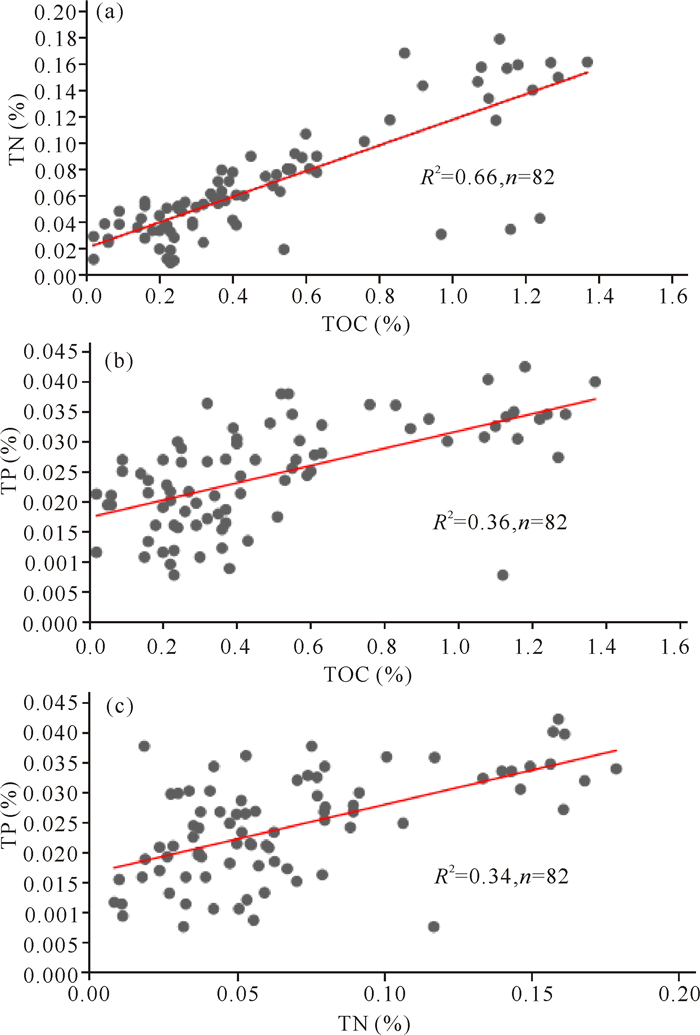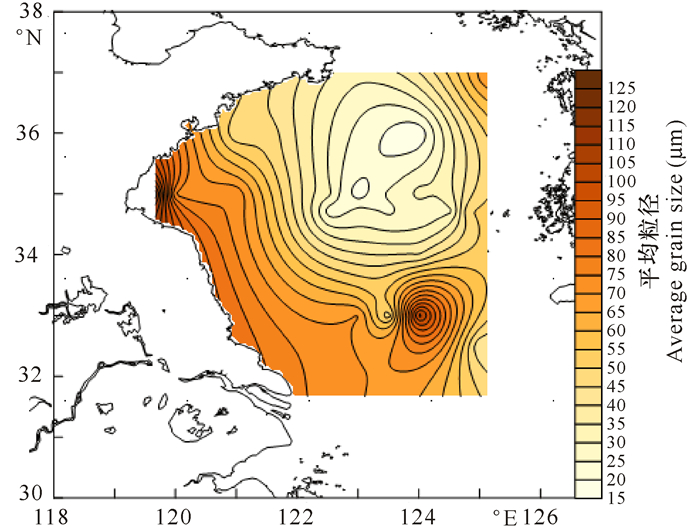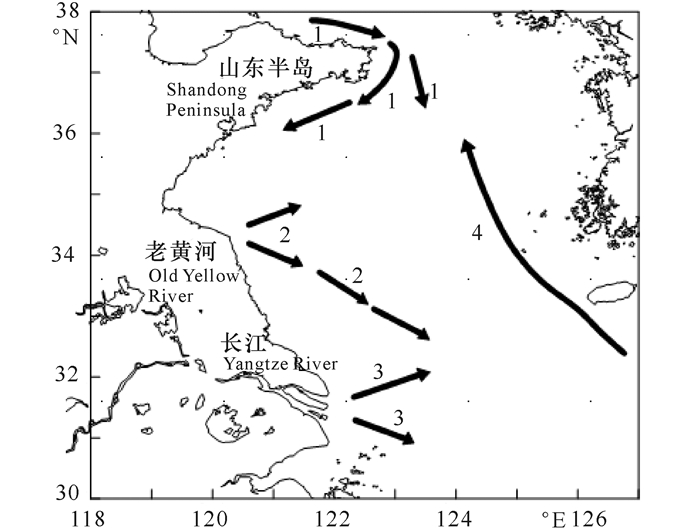2. 中国地质大学(武汉)地球科学学院,湖北武汉 430074;
3. 中国科学院海洋研究所,山东青岛 266071
2. School of Earth Science, China University of Geosciences (Wuhan), Wuhan, Hubei, 430074, China;
3. Institute of Oceanology, Chinese Academy of Sciences, Qingdao, Shandong, 266071, China
【研究意义】南黄海是山东半岛的成山角与朝鲜白翎岛连线以南和长江口与济州岛连线以北的椭圆形半封闭海域。南黄海具有典型的陆架近海特点,有大量陆源输入物质在近岸沉积,但又因水动力活跃造成近岸沉积发生改变[1]。南黄海表层沉积物中生源要素总有机碳(TOC)、总氮(TN)及总磷(TP)等来源于陆源输入和海洋自生。表层沉积物中生源要素含量分布规律在某种程度上受控于表层沉积物的粒度分布。其次,在不同的区域,沉积物中有机质的来源不同和水动力作用的差异性,也在一定程度上对沉积物中生源要素的含量分布造成影响[2-3]。另外,经济发展及人类活动加剧也很大程度上影响着表层沉积物中生源要素的分布规律。【前人研究进展】南黄海接受了大量来自近岸的物质沉积,物源的多样性使得沉积物中有机质存在差异性。南黄海以黄河输送的物质为主,同时有部分长江输入物质(主要在33°N以南区域)及黄海暖流带来的远洋物质的沉积[4]。老黄河、黄河及长江每年携带的大量泥砂颗粒及有机质输入到南黄海,在水动力作用下发生悬浮、搬运、迁移、沉降、堆积等一系列的作用,因在南黄海不同的区域水动力作用不同,最终造成南黄海的不同区域表层沉积物中元素分布存在较大的差异[5]。沉积物的粒度分布特征是物源供给、海流水动力环境、搬运距离等共同作用的结果[6]。粒度是影响沉积物中生源要素分布的因素,通常情况下,沉积物中细颗粒所占比重越大,比表面积越大,吸附能力越强,则生源要素含量越高[3, 7-8]。相反,沉积物的粒度越粗,则所含生源要素的含量就越低。研究表明,中国东部近海元素的含量受沉积物粒度的影响[2, 7]。【本研究切入点】本研究通过分析生源要素与沉积物粒度的相关关系,探讨了有机质来源及水动力作用对表层沉积物中生源要素分布的影响。【拟解决的关键问题】揭示表层沉积物粒度对生源要素的控制及其他因素对生源要素含量分布的影响。
1 材料与方法于2007年在南黄海海区采集82个表层沉积物样品(0~2 cm)(图 1),采集的样品均于-20℃冷冻保存带回实验室备用。取适量样品用粒度分析仪(Mastersizer 2000) 测定沉积物的粒度组成,同时取适量样品冷冻干燥后用5% HCl浸泡去除无机碳,之后用去离子水清洗盐酸直至中性,烘干后取适量用元素分析仪(EA3000) 进行TOC、TN和TP含量的测定。探讨影响表层沉积物中生源要素分布的主要因素。

|
图 1 南黄海采样站位图 Fig.1 Sampling sites of the South Yellow Sea |
南黄海表层沉积物中TOC的含量为0.02%~1.37%,平均值为0.48%,存在较大的差异。TOC的高值区主要分布在南黄海中部,含量基本高于0.50%,整体呈现出由南黄海中部向外逐渐递减的趋势(图 2a),低值区位于南黄海西部近岸,含量多在0.25%以下。

|
图 2 南黄海表层沉积物中TOC、TN和TP平面分布 Fig.2 Distributions of TOC, TN and TP in the surface sediments from the South Yellow Sea |
南黄海表层沉积物中TN的含量为0.0084%~0.1787%,平均值为0.0673%,TN在不同站位表层沉积物中的变化较大。TN的高值区主要分布在南黄海中部,含量多在0.0700%以上,TN的含量以南黄海中部为中心向外逐渐递减(图 2b),TN的低值区分布在南黄海西部近岸和山东半岛的南部沿岸,但在老黄河口东部的邻近区域和山东海阳及胶州湾的邻近区域其含量略有升高,与TOC的分布趋势相似。
2.1.3 TP的分布南黄海表层沉积物中TP的含量为0.0076%~0.0423%,平均值为0.0244%。表层沉积物中TP的含量波动较小,在研究区TP分布相对均匀,但也存在明显的高低值区(图 2c)。研究区大部分区域沉积物中TP的含量在0.0240%以上,高值区以南黄海北部和老黄河口与南黄海中部区域为主。TP的低值区主要位于长江口以北区域,含量低于0.0200%。TP的含量分布与TOC、TN的含量分布存在较大差异。
2.2 影响表层沉积物中生源要素分布的因素 2.2.1 有机质来源有机质的C/N比是一种区分海洋中有机质来源的指标。综合前人的研究结果[9-14]分析表明, C/N比值小于5以海洋自生有机质为主,C/N比值大于12以陆源输入为主,C/N比值越大,代表陆源有机质的输入量越大,C/N比值介于两者之间则被认为有机质为混合来源。南黄海82个站位表层沉积物中TOC/TN比值为0.8~40.1,平均值为9.5。结果显示:TOC/TN<5的表层沉积物占13.4%,TOC/TN为5~12的表层沉积物占73.2%,TOC/TN>12的表层沉积物占13.4%(表 1),表明南黄海研究区大部分区域的表层沉积物有机质为混源,是由海洋自生和陆源输入的有机质共同产生的结果。
| 表 1 南黄海表层沉积物中有机质TOC/TN比值的站位数分布 Table 1 Distribution points in TOC/TN rations of organic matters in the surface sediments from the South Yellow Sea |
南黄海表层沉积物中各生源要素之间存在显著的相关关系(图 3)。沉积物中TOC与TN的含量之间具有显著的正相关性(R2=0.66)(图 3a),说明沉积物中TOC和TN具有相同的来源。TOC与TP(R2=0.36)(图 3b)、TN与TP(R2=0.34)(图 3c)的相关性分析结果表明TOC、TN和TP的来源大致相同。

|
图 3 南黄海表层沉积物中各生源要素之间的相关关系 Fig.3 Correlation of different biogenic elements in the surface sediments from the South Yellow Sea |
南黄海表层沉积物的粒度分布特征总体呈现出自南黄海沿岸区域向中部海域逐渐变细的趋势(图 4)。即在南黄海的中央海域,表层沉积物的粒径较细,沉积物粒径以小于31 μm(细粒级)为主,这与中外学者历年来对黄海沉积物的调查研究一致[6, 15-16]。在山东半岛南侧及南黄海西部近岸区域,其表层沉积物的粒径较粗,沉积物粒径以大于63 μm(粗粒级)为主,其中在海州湾附近区域,表层沉积物的平均粒径更大,为砂质沉积区[15, 17]。

|
图 4 南黄海表层沉积物的平均粒径分布 Fig.4 Distribution of the average grain size of surface sediments from the South Yellow Sea |
在南黄海中部,表层沉积物主要以黏土和粉砂为主,黏土具有很强的吸附能力,致使该区域的生源要素含量较高。生源要素高含量区与泥质区相吻合,且生源要素与粒度呈显著的相关关系(图 5),表明沉积物粒度在很大程度上控制着生源要素含量分布。

|
图 5 南黄海表层沉积物的平均粒径与各生源要素的相关关系 Fig.5 Correlation of the average grain size and different biogenic elements contents in the surface sediments from the South Yellow Sea |
南黄海表层沉积物的平均粒径与TOC呈显著的负相关关系(r=-0.74)(图 5a);与TN呈较好的负相关关系(r=-0.65)(图 5b);与TP也存在较好的相关关系(r=-0.56)(图 5c)。即表层沉积物粒度越细,生源要素含量越高。
2.2.3 水动力作用南黄海处于复杂的水动力作用下,有黄海沿岸流、苏北沿岸流、老黄河水、长江水、南黄海涡流及黄海暖流等作用(图 6),对南黄海表层沉积物中生源要素含量分布也造成了影响[17-18]。

|
1.黄河水;2.苏北老黄河水;3.长江水;4.黄海暖流 1.Yellow River water; 2.Subei Old Yellow River water; 3.Yangtze River water; 4.Yellow Sea warm current 图 6 南黄海海域环流(图据赵一阳等[15]与申顺喜等[19]略改) Fig.6 Surface water currents in the South Yellow Sea(According to Zhao Y Y, et al.[15] and Shen S X, et al.[19] slightly modified) |
水动力作用造成入海颗粒物质不断地被搬运、迁移,且颗粒态物质在此过程中经历不同的变化,造成在不同海区表层沉积物中生源要素含量不同。首先,南黄海近岸水深较浅、各沿岸流明显,水动力作用活跃使得径流入海的细颗粒质被各沿岸流冲刷携带至水动力较弱、水深较大的区域,近岸则沉积粗粒的砂质沉积物,因粗粒沉积物对生源要素吸附较弱,造成近岸区域沉积物中TOC、TN、TP含量较低。其次,因南黄海中部受气旋式涡流和水动力较弱的冷水团的作用[15-16],经沿岸流冲刷悬浮的较细颗粒物质,随近岸到南黄海中部水动力作用的逐渐减弱,悬浮的颗粒物质按粒度大小依次沉降,在中部形成泥质区及TOC、TN、TP高含量区。另外,南黄海还受来自黄海暖流影响,黄海暖流向北流动,所携带的悬浮颗粒物质在运移过程中沉积在它流径区域的表层沉积物中[4, 20-21],从而对表层沉积物中生源要素含量造成差异,其中,近南黄海中部沉积的泥质沉积物对悬浮颗粒物的吸附力较大,沉积的生源要素通量较大。水动力作用主要影响沉积物粒度大小,造成沉积物粒径大小按水动力强弱分布的规律,最终导致表层沉积物中生源要素含量不同。南黄海近岸虽以粗粒的沉积物为主,对生源要素的吸附能力弱,但受人类活动的干预、河流有机质的输入较强等原因,在一定程度上对南黄海表层沉积物中生源要素的分布也造成了影响[22-23]。最终在河口、海湾等地表现为生源要素高值区,造成生源要素的含量相对要高于所研究区粗粒度与细粒度之间过渡区域的含量值。
3 结论本项研究主要从南黄海表层沉积物中生源要素含量分布特征和表层沉积物的平均粒径分布入手,分析南黄海表层沉积物中各生源要素与平均粒径之间的相关关系,发现TOC、TN和TP与沉积物的粒度呈现出相同的规律,即生源要素自南黄海中部向岸,含量逐渐降低,而沉积物粒度呈现出自岸边向中心变细的规律,依据相关关系分析结果,表层沉积物中生源要素TOC、TN、TP和平均粒径之间存在显著的负相关关系,说明表层沉积物的粒度直接控制着生源要素的分布。根据南黄海表层沉积物中TOC/TN比,及各生源要素TOC、TN、TP彼此之间的正相关关系,说明有机质中各生源要素有相同的来源,同时在一定程度上也影响着生源要素的分布。另外,水动力作用也从一定程度上影响沉积物中生源要素的分布。同时,生源要素TP与其他生源要素TOC、TN之间相对较弱的相关关系和近岸河口等地生源要素高值区域表明,可能有其他的外部环境因素对TP的含量造成影响。可能包含有海底生物的扰动及人类活动等因素作用。
| [1] |
吕晓霞, 宋金明. 南黄海表层沉积物中氮的区域地球化学特征[J]. 海洋科学进展, 2003, 21(2): 174-180. LV X X, SONG J M. Regional geochemical characteristics of nitrogen in the southern Yellow Sea surface sediment[J]. Advances in Marine Science, 2003, 21(2): 174-180. |
| [2] |
吕晓霞, 翟世奎, 于增慧. 长江口及邻近海域表层沉积物中营养元素的分布特征及其控制因素[J]. 海洋环境科学, 2005, 24(3): 1-5. LV X X, ZHAI S K, YU Z H. Nutrient distribution and controlled factors at the surface sediment of the Changjiang Estuary and adjacent sea area[J]. Marine Environmental Science, 2005, 24(3): 1-5. |
| [3] |
岳维忠, 黄小平. 近海沉积物中氮磷的生物地球化学研究进展[J]. 台湾海峡, 2003, 22(3): 407-414. YUE W Z, HUANG X P. Advance in biogeochemistry studies on nitrogen and phosphorus in offshore sediment[J]. Journal of Oceanography in Taiwan Strait, 2003, 22(3): 407-414. |
| [4] |
蓝先洪, 张训华, 张志珣. 南黄海沉积物的物质来源及运移研究[J]. 海洋湖沼通报, 2005(4): 53-60. LAN X H, ZHANG X H, ZHANG Z X. Material sources and transportation of sediments in the southern Yellow Sea[J]. Transactions of Oceanology and Limnology, 2005(4): 53-60. |
| [5] |
王保栋, 战闰, 藏家业. 长江口及其邻近海域营养盐的分布特征和输送途径[J]. 海洋学报, 2002, 24(1): 53-58. WANG B D, ZHAN R, ZANG J Y. Distributions and transportation of nutrients in Changjiang River Estuary and its adjacent sea areas[J]. Acta Oceanologica Sinica, 2002, 24(1): 53-58. |
| [6] |
蒲晓强, 陶小晚. 南黄海部分典型海域沉积物粒度特征[J]. 海洋科学, 2009, 33(8): 63-66. PU X Q, TAO X W. Grain size character of sediments in some typical marine areas of the southern Yellow Sea[J]. Marine Sciences, 2009, 33(8): 63-66. |
| [7] |
LV X X, SONG J M, YUAN H M, et al. Grain-size related nitrogen distribution in southern Yellow Sea surface sediments[J]. Chinese Journal of Oceanology and Limnology, 2005, 23(3): 306-316. |
| [8] |
宋国栋, 刘素美, 张国玲. 黄东海表层沉积物中磷的分布特征[J]. 环境科学, 2014, 35(1): 157-162. SONG G D, LIU S M, ZHANG G L. Study on distribution of phosphorus in surface sediments of the Yellow Sea and the East China Sea[J]. Environmental Science, 2014, 35(1): 157-162. |
| [9] |
EMERSON S, HEDGES J I. Processes controlling the organic carbon content of open ocean sediments[J]. Paleoceanography, 1988, 3(5): 621-634. DOI:10.1029/PA003i005p00621 |
| [10] |
MEYERS P A. Preservation of elemental and isotopic source identification of sedimentary organic matter[J]. Chemical Geology, 1994, 144(3/4): 289-302. |
| [11] |
MEYERS P A. Organic geochemical proxies of paleoceanographic, paleolimnologic, and paleoclimatic processes[J]. Organic Geochemistry, 1997, 27(5/6): 213-250. |
| [12] |
吕晓霞, 翟世奎, 牛丽凤. 长江口柱状沉积物中有机质C/N比的研究[J]. 环境化学, 2005, 24(3): 255-259. LV X X, ZHAI S K, NIU L F. Study on the C/N ratios of organic matters in the core sediments of the Yangtze River Estuary[J]. Environmental Chemistry, 2005, 24(3): 255-259. |
| [13] |
熊林芳, 石学法, 邓煜, 等. 南黄海、东海北部陆架区表层沉积物有机质分布特征[J]. 海洋通报, 2013, 32(3): 281-286. XIONG L F, SHI X F, DENG Y, et al. Distribution characteristics of the organic matter in the surficial sediments on the shelf of the southern Yellow Sea and the northern East China Sea[J]. Marine Science Bulletin, 2013, 32(3): 281-286. |
| [14] |
ZHU C, WANG Z H, XUE B, et al. Characterizing the depositional settings for sedimentary organic matter distributions in the Lower Yangtze River-East China Sea shelf system[J]. Estuarine, Coastal and Shelf Science, 2011, 93(3): 182-191. DOI:10.1016/j.ecss.2010.08.001 |
| [15] |
赵一阳, 李凤业, 秦朝阳, 等. 试论南黄海中部泥的物源及成因[J]. 地球化学, 1991(2): 112-117. ZHAO Y Y, LI F Y, QIN Z Y, et al. Source and genesis of mud in the central part of the South Yellow Sea in special reference to geochemical data[J]. Geochemica, 1991(2): 112-117. |
| [16] |
徐刚, 刘健, 孔祥淮, 等. 南黄海中部泥质沉积成因和物源研究综述[J]. 海洋地质动态, 2010, 26(2): 8-12. XU G, LIU J, KONG X H, et al. Sedimentary origin and provenance of the muddy deposition in the central South Yellow Sea[J]. Marine Geology Letters, 2010, 26(2): 8-12. |
| [17] |
张宪军, 蓝先洪, 赵广涛, 等. 南黄海中西部表层沉积物粒度特征分析[J]. 海洋地质动态, 2007, 23(7): 8-13. ZHANG X J, LAN X H, ZHAO G T, et al. Analysis of grain sizes of surface sediments in the central west area of the South Yellow Sea[J]. Marine Geology Letters, 2007, 23(7): 8-13. |
| [18] |
蔡德陵, 石学法, 周卫健, 等. 南黄海悬浮体和沉积物的物质来源和运移:来自碳稳定同位素组成的证据[J]. 科学通报, 2003, 46(S1): 16-23. CAI D L, SHI X F, ZHOU W J, et al. Sources and transportation of suspended matter and sediment in the South Yellow Sea:Evidence from stable carbon isotopes[J]. Chinese Science Bulletin, 2003, 46(S1): 16-23. |
| [19] |
申顺喜, 陈丽蓉, 高良, 等. 南黄海冷涡沉积和通道沉积的发现[J]. 海洋与湖沼, 1993, 24(6): 563-570. SHEN S X, CHEN L R, GAO L, et al. Discovery of holocene cyclonic eddy sediment and pathway sediment in the southern Yellow Sea[J]. Oceanologia et Limnologia Sinica, 1993, 24(6): 563-570. |
| [20] |
林承坤. 黄海粘土沉积物的来源与分布[J]. 地理研究, 1992, 11(2): 41-51. LIN C K. A study on the source and the distribution of clay at the Yellow Sea[J]. Geographical Research, 1992, 11(2): 41-51. |
| [21] |
赵一阳, 朴龙安, 秦蕴珊, 等. 南黄海沉积学研究新进展——中韩联合调查[J]. 海洋科学, 1998, 22(1): 34-37. ZHAO Y Y, PIAO L A, QIN Y S, et al. Recent development in the southern Yellow Sea sedimentology-The China-Korea joint investigation[J]. Marine Sciences, 1998, 22(1): 34-37. |
| [22] |
高全洲, 陶贞. 河流有机碳的输出通量及性质研究进展[J]. 应用生态学报, 2003, 14(6): 1000-1002. GAO Q Z, TAO Z. Advances in studies on transported flux and properties of riverine organic carbon[J]. Chinese Journal of Applied Ecology, 2003, 14(6): 1000-1002. |
| [23] |
王润梅, 唐建辉, 黄国培, 等. 环渤海地区河流河口及海洋表层沉积物有机质特征和来源[J]. 海洋与湖沼, 2015, 46(3): 497-507. WANG R M, TANG J H, HUANG G P, et al. Provenance of organic matter in estuarine and marine surface sediments around the Bohai Sea[J]. Oceanologia et Limnologia Sinica, 2015, 46(3): 497-507. DOI:10.11693/hyhz20140800225 |
 2017, Vol. 33
2017, Vol. 33 


